Hola amigos: A VUELO DE UN QUINDE EL BLOG., hemos recibido una amplia información del The National Science Foundation (NSF), que nos nos informa que : desde 2011 en las profundidades del lago Erie, ha aparecido una alga llamada en inglés: algae bloom,de color verde, cerca a la Isla Pelee , en Ontario; esta alga está sofocando a los peces matándolos; esta alga que mata todos los records en abundancia se origina por los desechos de las actividades agrícolas, a precipitaciones extremas, a la circulación muy débil de las aguas del lago y a temperaturas muy calientes según lo afirman los científicos. Asimismo agregan que: Los factores que condujeron a esta explosión de las algas son relacionados todos con la gente y nuestra interacción con el entorno. Los invito a leer la versión en inglés.........
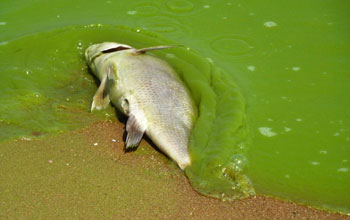
Fish suffocated in the Lake Erie algae bloom of August 2011, near Pelee Island, Ontario.
Credit: Tom Archer
Download the high-resolution JPG version of the image. (112 KB)
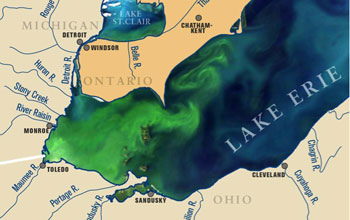
Lake Erie algae bloom in September 2011, covering the lake's entire western basin.
Credit: Michigan Sea Grant
Download the high-resolution JPG version of the image. (90 KB)

Cup of fouled water, scooped from Lake Erie during the algae bloom.
Credit: Tom Bridgeman
Download the high-resolution JPG version of the image. (48 KB)
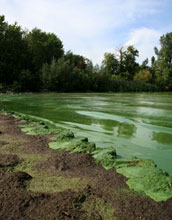
The 2011 Lake Erie algae bloom resulted from record-breaking nutrient loads.
Credit: Todd Crail
Download the high-resolution JPG version of the image. (81 KB)
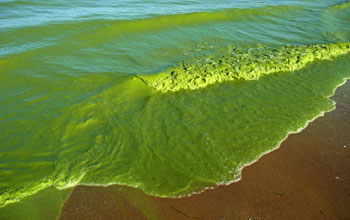
Algae wash ashore in waves on Lake Erie's southeastern shore.
Credit: Tom Archer
Download the high-resolution JPG version of the image. (136 KB)
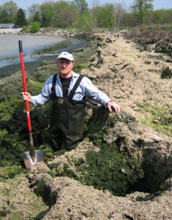
Researcher amid an algae accumulation along Lake Erie's southwestern shoreline.
Credit: David Hartson
Download the high-resolution JPG version of the image. (86 KB)
A 2011 record-breaking algae bloom in Lake Erie was triggered by
long-term agricultural practices coupled with extreme precipitation,
followed by weak lake circulation and warm temperatures, scientists have
discovered.
The researchers also predict that, unless agricultural policies change, the lake will continue to experience extreme blooms.
"The
factors that led to this explosion of algal blooms are all related to
humans and our interaction with the environment," says Bruce Hamilton,
program director at the National Science Foundation (NSF), which funded
the research through its Water, Sustainability and Climate (WSC)
Program.
WSC is part of NSF's Science, Engineering and Education for Sustainability (SEES) initiative.
"Population
growth, changes in agricultural practices and climate change are all
part of the equation," says Hamilton. "These findings show us where we
need to focus our attention in the future."
Results of the research are published in this week's online early edition of the journal Proceedings of the National Academy of Sciences (PNAS).
"The
'perfect storm' of weather events and agricultural practices that
occurred in 2011 is unfortunately consistent with ongoing trends," says
Anna Michalak, the paper's lead author and a scientist at the Carnegie
Institution for Science's Department of Global Ecology, located at
Stanford University.
"That means that more huge algal blooms can
be expected in the future, unless a scientifically-guided management
plan is implemented for the region."
Freshwater algal blooms may
result when high amounts of phosphorus and nitrogen are added to the
water, usually as runoff from fertilizer.
These excess nutrients encourage unusual growth of algae and aquatic plants.
When
the plants and algae die, decomposers in the water that feed on them
use up oxygen, which can drop to levels too low for aquatic life to
thrive.
At first the Lake Erie algae were almost entirely Microcystis, an organism that produces a liver toxin and can cause skin irritation.
The scientists combined sampling and satellite-based observations of the lake with computer simulations to track the bloom.
It began in the lake's Western region in mid-July and covered an area of 230 square miles.
At
its peak in October, the bloom had expanded to more than 1,930 square
miles. Its peak intensity was more than three times greater than any
other bloom on record.
The researchers looked at numerous factors
that could have contributed to the bloom, including land-use,
agricultural practices, runoff, wind, temperature, precipitation and
circulation.
They found that three agriculture management
practices in the area can lead to increased nutrient runoff: autumn
fertilization, broadcast fertilization (uniform distribution of
fertilizer over the whole cropped field), and reduced tillage.
These practices have increased in the region over the last decade.
Conditions
in the fall of 2010 were ideal for harvesting and preparing fields and
increasing fertilizer application for spring planting.
A series of strong storms the following spring caused large amounts of phosphorus to flow into the lake.
In May alone rainfall was more than 6.5 inches, a level more than 75 percent above the prior 20-year average for the month.
This onslaught resulted in one of the largest spring phosphorus loads since 1975, when intensive monitoring began.
Lake
Erie was not unusually calm and warm before the bloom. But after the
bloom began, warmer water and weaker currents encouraged a more
productive bloom than in prior years.
The longer period of weak circulation and warmer temperatures helped incubate the bloom and allowed the Microcystis
to remain near the top of the water column. That had the added effect
of preventing the nutrients from being flushed out of the system.
The
researchers' data did not support the idea that land-use and crop
choices contributed to the increase in nutrient run-off that fueled the
bloom.
To determine the likelihood of future mega-blooms, the
scientists analyzed climate model simulations under both past and future
climate conditions.
They found that severe storms become more
likely in the future, with a 50 percent increase in the frequency of
precipitation events of .80 inch or more of rain.
Stronger storms, with greater than 1.2 inch of rain, could be twice as frequent.
The
researchers believe that future calm conditions with weak lake
circulation after a bloom's onset are also likely to continue, since
current trends show decreasing wind speeds across the United States.
That would result in longer-lasting blooms and decreased mixing in the water column.
"Although
future strong storms may be part of the new normal," says Michalak,
"better management practices could be implemented to provide some relief
to the problem."
The research was also supported by the NOAA Center for Sponsored Coastal Ocean Research and the Lake Erie Protection Fund.
-NSF-
Media Contacts
Cheryl Dybas, NSF (703) 292-7734 cdybas@nsf.gov
Tina McDowell, Carnegie Institution for Science (202) 939-1120
Tina McDowell, Carnegie Institution for Science (202) 939-1120
Related WebsitesHow Is Earth's Water System Linked With Land Use, Climate Change and Ecosystems?:
http://www.nsf.gov/news/news_summ.jsp?cntn_id=125434&org=NSF&from=news
NSF Awards Grants for Study of Water Sustainability and Climate:
NSF Awards Grants for Study of Water Sustainability and Climate:
http://www.nsf.gov/news/news_summ.jsp?cntn_id=117819
Science, Engineering and Education for Sustainability NSF-Wide Investment (SEES): http://www.nsf.gov/sees/
NSF "Discoveries in Sustainability" Publication: http://www.nsf.gov/pubs/2012/disco12001/disco12001.pdf
Science, Engineering and Education for Sustainability NSF-Wide Investment (SEES): http://www.nsf.gov/sees/
NSF "Discoveries in Sustainability" Publication: http://www.nsf.gov/pubs/2012/disco12001/disco12001.pdf
The National Science Foundation (NSF) is an independent federal
agency that supports fundamental research and education across all
fields of science and engineering. In fiscal year (FY) 2012, its budget
is $7.0 billion. NSF funds reach all 50 states through grants to nearly
2,000 colleges, universities and other institutions. Each year, NSF
receives over 50,000 competitive requests for funding, and makes about
11,000 new funding awards. NSF also awards nearly $420 million in
professional and service contracts yearly.
Useful NSF Web Sites:
NSF Home Page: http://www.nsf.gov
NSF News: http://www.nsf.gov/news/
For the News Media: http://www.nsf.gov/news/newsroom.jsp
Science and Engineering Statistics: http://www.nsf.gov/statistics/
Awards Searches: http://www.nsf.gov/awardsearch/
NSF Home Page: http://www.nsf.gov
NSF News: http://www.nsf.gov/news/
For the News Media: http://www.nsf.gov/news/newsroom.jsp
Science and Engineering Statistics: http://www.nsf.gov/statistics/
Awards Searches: http://www.nsf.gov/awardsearch/
Guillermo Gonzalo Sánchez Achutegui
ayabaca@hotmail.com
ayabaca@gmail.,com
ayabaca@yahoo.com

No hay comentarios:
Publicar un comentario